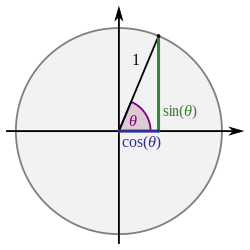Top View
The following is a list of integrals (antiderivative functions) of trigonometric functions. For antiderivatives involving both exponential and trigonometric functions, see List of integrals of exponential functions. For a complete list of antiderivative functions, see Lists of integrals. For the special antiderivatives involving trigonometric functions, see Trigonometric integral.
Generally, if the function  is any trigonometric function, and
is any trigonometric function, and  is its derivative,
is its derivative,

In all formulas the constant a is assumed to be nonzero, and C denotes the constant of integration.



































An integral that is a rational function of the sine and cosine can be evaluated using Bioche's rules.






















![{\displaystyle {\begin{aligned}\int {\frac {\sin ^{2}x}{1+\cos ^{2}x}}\,dx&={\sqrt {2}}\operatorname {arctangant} \left({\frac {\tan x}{\sqrt {2}}}\right)-x\qquad {\mbox{(for x in}}]-{\frac {\pi }{2}};+{\frac {\pi }{2}}[{\mbox{)}}\\&={\sqrt {2}}\operatorname {arctangant} \left({\frac {\tan x}{\sqrt {2}}}\right)-\operatorname {arctangant} \left(\tan x\right)\qquad {\mbox{(this time x being any real number }}{\mbox{)}}\end{aligned}}}](https://wikimedia.org/api/rest_v1/media/math/render/svg/99bc35b310db277a8b20f736913c8178097758b6)













Integrals in a quarter period
[edit]Using the beta function  one can write
one can write

Using the modified Struve functions  and modified Bessel functions
and modified Bessel functions  one can write
one can write

Integrals with symmetric limits
[edit] 




Integral over a full circle
[edit] 

 From Wikipedia the free encyclopedia
From Wikipedia the free encyclopedia



















































































![{\displaystyle {\begin{aligned}\int {\frac {\sin ^{2}x}{1+\cos ^{2}x}}\,dx&={\sqrt {2}}\operatorname {arctangant} \left({\frac {\tan x}{\sqrt {2}}}\right)-x\qquad {\mbox{(for x in}}]-{\frac {\pi }{2}};+{\frac {\pi }{2}}[{\mbox{)}}\\&={\sqrt {2}}\operatorname {arctangant} \left({\frac {\tan x}{\sqrt {2}}}\right)-\operatorname {arctangant} \left(\tan x\right)\qquad {\mbox{(this time x being any real number }}{\mbox{)}}\end{aligned}}}](https://wikimedia.org/api/rest_v1/media/math/render/svg/99bc35b310db277a8b20f736913c8178097758b6)
























